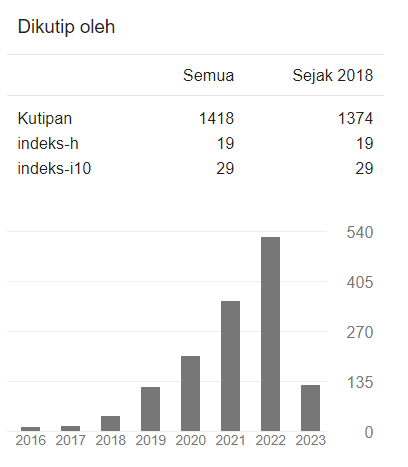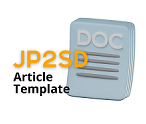Buku Digital untuk Pembelajaran di Era Society 5.0
DOI:
https://doi.org/10.22219/jp2sd.v11i1.25674Keywords:
Era Society 5.0, Independent Digital Book, Thematic LearningAbstract
In Society 5.0, technological developments are speedy and rapid. Human life is side by side with technological progress. Therefore, the use of technology in society is evenly distributed. Many conveniences are obtained using Android, including learning resources that add insight or reading material. This research is R&D with the ADDIE development model. The product of this research is a digital learning book sub-theme four, living in harmony in society. The purpose of this research and development is to produce a product that is valuable, effective, practical and attractive. Product test results resulted in media expert validation of 90%, while material validation was 86%. The results of the two validations are average in the excellent category. The results of the effectiveness test were obtained from student learning outcomes through evaluation questions with an average of 87 and a completeness percentage of 92.85%, and these results were included in the very effective and complete category. The results of the practicality test obtained a percentage of 95% of teachers and 96.72% of students included in the practical category. The results of the attractiveness test showed that the percentage of students was 96.52% which was included in the desirable category. Based on the explanation above, it shows that independent digital books as alternative teaching material in Society 5.0 are appropriate to use in the category of valid, effective, practical and interesting.
Downloads
References
Agustina, R. S. (2022). Development of Mind Mapping Based Prezi Multimedia to Improve History Learning Outcomes. 129-139.
Arsyad, A. (2011). Media Pembelajaran. Jakarta: PT. Raja Grafindo Persada.
Branch, R. M. (2009). Instructional Design: The ADDIE Approach. New York: Springer New York Dordrecht Heidelberg London.
Cholik, C. (2017). Pemanfaatan Teknologi Informasi dan Komunikasi untuk Meningkatkan Pendidikan Indonesia. Jurnal ilmiah indonesia, 40-42.
Dviyana, G. D. (2016). Pemberdayaan Materi Ajar Berbentuk Digital Menggunakan Aplikasi Open Office Sun Microsystem Bagi Guru-Guru Sma Se-Kecamatan Ubud. Jurnal Widya Laksana, 69-75.
Fauziyah, L. N. (2022). Implementasi Penguatan Pendidikan Karakter pada Video Pembelajaran yang Dikembangkan oleh Guru-Guru di Korwil 1 MKKS SMP Swasta Kota Malang. Jurnal Integrasi dan Harmoni Inovatif Ilmu-Ilmu Sosial, 1-8.
Fitria, R. U. (2021). Pengembangan Video Pembelajaran Matematika Menggunakan Camtasia Studio dan Powerpoint pada Materi Lingkaran Kelas VIII SMP/MTS. Jurnal JP3, 68-75.
Hanif, M. (2018). Pengembangan Media Pembelajaran Buku Saku Digital Untuk Kompetensi Dasar Teknik Memperoleh Modal Usaha Kelas X Pemasaran SMK. Jurnal Pendidikan Tata Niaga, 145-150.
Hilir, A. (2021). Pengembangan Teknologi Pendidikan: Peranan Pendidik dalam Menggunakan Media Pembelajaran. Klaten: Lakeisha.
Kusumam, A. M. (2016). Pengembangan Bahan Ajar Mata Pelajaran Dasar dan Pengukuran Listrik untuk Sekolah Menengah Kejuruan. jurnal pendidikan teknologi dan kejuruan, 28.
Listiawan, S. &. (2019). Pengembangan Buku Digital Pada Materi Komunikasi Dalam Jaringan Mata Pelajaran Simulasi Dan Komunikasi Digital Kelas X Smk Perwari Tulungagung. JOEICT (Jurnal of Education and Information Communication Technology), 55-65.
Mastura & Santaria, R. (2020). Dampak Pandemi Covid-19 terhadap Proses Pengajaran bagi Guru dan Siswa Pendahuluan. Jurnal Studi Guru dan Pembelajaran, 289-295.
Nurrita. (2018). Pengembangan Media Pembelajaran untuk Meningkatkan Hasil Belajar Siswa. . Misykat, 171-187.
Pahlevi, M. R. (2021). Pengembangan Bahan Ajar Berbasis History Mapping Pada Materi Sejarah Perkembangan Kota Palembang. Jurnal Agastya, 146-157.
Prasetya, D. D. (2017). Buku Digital Anak Berbasis Mobile. tekno, 26.
Priyanto. (2012). Belajar Cepat Olah Data Statistik Dengan SPSS. yogyakarta: Cv Andi Offest.
Putri, Y. F. (2017). Pengembangan Aplikasi Buku Saku Berbasis Android Sebagai Media Pembelajaran Hukum Kesehatan di Akademi Farmasi Surabaya. surabaya: it-edu2.
Rachmadtullah, R. K. (2022). Pengembangan Video Pembelajaran Sederhana: PPM Bagi Guru SDN Sumur Welut III/440 Surabaya. Jurnal Kanigara, 58-65.
Saputra, M. R. (2021). Pengembangan Bahan Ajar Sejarah Berbasis WEB. Solo: Yayasan Lembaga Gumun Indonesia (YLGI).
Sari, A. (2016). Pengembangan Buku Digital Melalui Aplikasi Sigil pada Mata Kuliah Cookies and Candys Science Tech. Jurnal Ilmiah Ilmu Pengetahuan dan Teknologi, 46-54.
Sugiharni, G. (2018). Pengembangan Modul Matematika Diskrit Berbentuk Digital Dengan Pola Pendistribusian Asynchronous Menggunakan Teknologi Open Source. Jurnal Nasional Pendidikan Teknik Informatika, 58-72.
Sugiyono. (2018). Metode Penelitian Pendidikan Pendekatan Kuantitatif, Kualitatif dan R&D. Bandung: Alfabeta.
Suryadi, R. A. (2019). Desain dan Perencanaan Pembelajaran. Yogyakarta: Deepublish.
Suwarno, W. (2018). Perpustakaan & buku: . Jogyakarta: Ar-Ruzz Media.
Tegeh, M. (2014). Model Penelitian Pengembangan. Yogyakarta: Graha Ilmu.
Tunjung, A. S. (2020). Kreativitas Guru Ips Dalam Pengembangan Media Pembelajaran Pada Smp Negeri 2 Semarang Dan Mts Negeri 1 Semarang. Jurnal pembelajaran IPS dan pkn, 73-84.
Uno, H. (2011). Orientasi Baru dalam Psikologi Pembelajaran. Jakarta: Bumi Aksara.
Widodo, A. &. (2017). Pengembangan Media Pembelajaran Buku Saku Digital Berbasis Android Untuk Meningkatkan Minat Dan Hasil Belajar Fisika Peserta Didik Kelas Xi Sma N 1 Jetis Pada Materi Pokok Keseimbangan Benda Tegar. Jurnal Pendidikan Fisika, 147-154.
Wirasasmita, R. H. (2017). Pengembangan Media Pembelajaran Berbasis Buku Digital Elektronic Publication (Epub) Menggunakan Software Sigil pada Mata Kuliah Pemrograman Dasar. jurnal pendidikan informatika, 11-16.
Downloads
Published
Issue
Section
License
Copyright (c) 2023 Muhammad Saifudin Zuhri, Tutut Chusniyah, Muslihati

This work is licensed under a Creative Commons Attribution-ShareAlike 4.0 International License.
Authors who publish with Jurnal Pemikiran dan Pengembangan Sekolah Dasar (JP2SD) agree to the following terms:
- For all articles published in Jurnal Pemikiran dan Pengembangan Sekolah Dasar (JP2SD), copyright is retained by the authors. Authors give permission to the publisher to announce the work with conditions. When the manuscript is accepted for publication, the authors agree to automatic transfer of the publishing right to the publisher.
- Authors retain copyright and grant the journal right of first publication with the work simultaneously licensed under a Creative Commons Attribution-ShareAlike 4.0 International License that allows others to share the work with an acknowledgment of the work's authorship and initial publication in this journal.
- Authors are able to enter into separate, additional contractual arrangements for the non-exclusive distribution of the journal's published version of the work (e.g., post it to an institutional repository or publish it in a book), with an acknowledgment of its initial publication in this journal.
- Authors are permitted and encouraged to post their work online (e.g., in institutional repositories or on their website) prior to and during the submission process, as it can lead to productive exchanges, as well as earlier and greater citation of published work (See The Effect of Open Access).

This work is licensed under a Creative Commons Attribution-ShareAlike 4.0 International License.


















